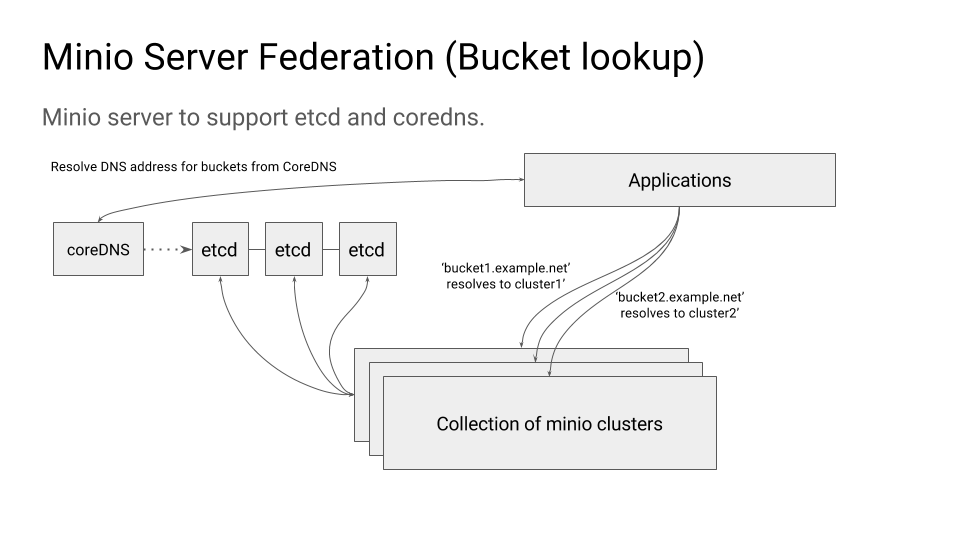- Sort Score
- Result 10 results
- Languages All
Results 1 - 10 of 22 for Beavers (0.19 sec)
-
okhttp-tls/README.md
Recommendations --------------- Typically servers need a held certificate plus a chain of intermediates. Servers only need the private key for their own certificate. The chain served by a server doesn't need the root certificate. The trusted roots don't need to be the same for client and server when using client authentication. Clients might rely on the platform certificates and servers might use a private
Plain Text - Registered: Fri May 03 11:42:14 GMT 2024 - Last Modified: Sun Dec 17 15:34:10 GMT 2023 - 9.1K bytes - Viewed (1) -
docs/federation/lookup/README.md
 ### Environment variables #### MINIO_ETCD_ENDPOINTS This is comma separated list of etcd servers that you want to use as the MinIO federation back-end. This should be same across the federated deployment, i.e. all the MinIO instances within a federated deployment should use same etcd back-end. #### MINIO_DOMAIN
Plain Text - Registered: Sun May 05 19:28:20 GMT 2024 - Last Modified: Thu Sep 29 04:28:45 GMT 2022 - 4K bytes - Viewed (0) -
docs/bucket/notifications/README.md
``` MinIO supports all the exchanges available in [RabbitMQ](https://www.rabbitmq.com/). For this setup, we are using `fanout` exchange. MinIO also sends with the notifications two headers: `minio-bucket` and `minio-event`. An exchange using the type "headers" can use this information to route the notifications to proper queues.
Plain Text - Registered: Sun May 05 19:28:20 GMT 2024 - Last Modified: Thu Jan 18 07:03:17 GMT 2024 - 84K bytes - Viewed (2) -
docs/kms/README.md
``` export MINIO_KMS_AUTO_ENCRYPTION=on ``` ### Verify auto-encryption > Note that auto-encryption only affects requests without S3 encryption headers. So, if a S3 client sends > e.g. SSE-C headers, MinIO will encrypt the object with the key sent by the client and won't reach out to > the configured KMS. To verify auto-encryption, use the following `mc` command: ```
Plain Text - Registered: Sun May 05 19:28:20 GMT 2024 - Last Modified: Thu Jan 18 07:03:17 GMT 2024 - 7.1K bytes - Viewed (0) -
internal/grid/README.md
# MinIO Grid The MinIO Grid is a package that provides two-way communication between servers. It uses a single two-way connection to send and receive messages between servers. It includes built in muxing of concurrent requests as well as congestion handling for streams. Requests can be "Single Payload" or "Streamed". Use the MinIO Grid for: * Small, frequent requests with low latency requirements.
Plain Text - Registered: Sun May 05 19:28:20 GMT 2024 - Last Modified: Thu Jan 18 07:03:17 GMT 2024 - 9.4K bytes - Viewed (0) -
docs/bucket/retention/README.md
``` ### Set object lock PutObject API allows setting per object retention mode and retention duration using `x-amz-object-lock-mode` and `x-amz-object-lock-retain-until-date` headers. This takes precedence over any bucket object lock configuration w.r.t retention. ```sh
Plain Text - Registered: Sun May 05 19:28:20 GMT 2024 - Last Modified: Thu Sep 29 04:28:45 GMT 2022 - 3.9K bytes - Viewed (0) -
docs/metrics/prometheus/README.md
- MinIO exports Prometheus compatible data by default which is bucket centric as an authorized endpoint at `/minio/v2/metrics/bucket`. This document explains how to setup Prometheus and configure it to scrape data from MinIO servers. ## Prerequisites To get started with MinIO, refer [MinIO QuickStart Document](https://min.io/docs/minio/linux/index.html#quickstart-for-linux). Follow below steps to get started with MinIO monitoring using Prometheus.
Plain Text - Registered: Sun May 05 19:28:20 GMT 2024 - Last Modified: Fri Apr 12 15:49:30 GMT 2024 - 7.1K bytes - Viewed (0) -
helm/minio/README.md
```bash helm install --set tls.enabled=true,tls.certSecret=tls-ssl-minio minio/minio ``` ### Installing certificates from third party CAs
Plain Text - Registered: Sun May 05 19:28:20 GMT 2024 - Last Modified: Wed Jan 24 07:27:57 GMT 2024 - 10.9K bytes - Viewed (0) -
okhttp-logging-interceptor/README.md
} }); ``` **Warning**: The logs generated by this interceptor when using the `HEADERS` or `BODY` levels have the potential to leak sensitive information such as "Authorization" or "Cookie" headers and the contents of request and response bodies. This data should only be logged in a controlled way or in a non-production environment. You can redact headers that may contain sensitive information by calling `redactHeader()`. ```java
Plain Text - Registered: Fri May 03 11:42:14 GMT 2024 - Last Modified: Sun Dec 17 15:34:10 GMT 2023 - 1.3K bytes - Viewed (0) -
README.md
## Container Installation Use the following commands to run a standalone MinIO server as a container. Standalone MinIO servers are best suited for early development and evaluation. Certain features such as versioning, object locking, and bucket replication
Plain Text - Registered: Sun May 05 19:28:20 GMT 2024 - Last Modified: Wed Feb 14 17:51:34 GMT 2024 - 18.7K bytes - Viewed (0)